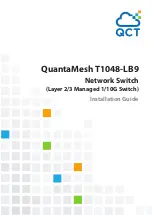
◦
MTU
—
The MTU that needs to be enforced for the traffic that is mapped to a system class.
Each system class has a default MTU and the system class MTU is configurable.
◦
Multicast optimization
—
This configuration specifies if the performance of multicast traffic
mapped to this class will be optimized.
◦
Pause no-drop
—
No drop specifies lossless service for the system class. Drop specifies that
tail drop is used (arriving packets are dropped when the queue reaches its allocated size)
when a queue for this system class is full.
An additional parameter pfc-cos can be configured. This parameter identifies the class of
service (CoS) values to assert priority flow control (PFC) when traffic for a no-drop system
class is not mapped based purely on CoS experiences congestion.
◦
You can change the buffer for the no-drop class.
◦
Queue Limit
—
This configuration specifies the number of buffers that need to be reserved to
the queues of this system class. This option is not configurable for no-drop system classes.
•
Type queuing
—
A type queuing policy is used to define the scheduling characteristics of the queues
associated with system classes.
Some configuration parameters when applied to an EtherChannel are not reflected on
the configuration of the member ports.
Note
◦
Classification
—
The traffic that matches this class are as follows:
◦
QoS Group
—
A class map of type queuing identifies a system class and is matched by its
associated QoS group.
◦
Policy
—
The actions that are performed on the matching traffic are as follows:
These policies can be attached to the system qos target or to any interface. The output
queuing policy is used to configure output queues on the device associated with system
classes. The input queuing policy is used to configure scheduling for queues in the CNA.
The input queuing policy parameters are signaled to the CNA over the DCBX protocol.
Note
◦
Bandwidth
—
Sets the guaranteed scheduling deficit weighted round robin (DWRR) percentage
for the system class.
◦
Priority
—
Sets a system class for strict-priority scheduling. Only one system class can be
configured for priority in a given queuing policy.
•
Type qos
—
A type QoS policy is used to classify traffic that is based on various Layer 2, Layer 3, and
Layer 4 fields in the frame and to map it to system classes.
Cisco Nexus 5000 NX-OS Quality of Service Configuration Guide, Release 5.1(3)N2(1)
18
OL-26657-01
Configuring Policy Maps
Information About Policy Types
















































